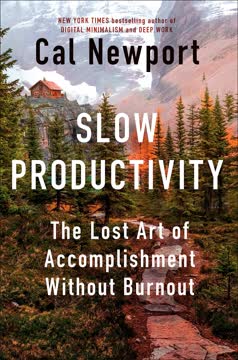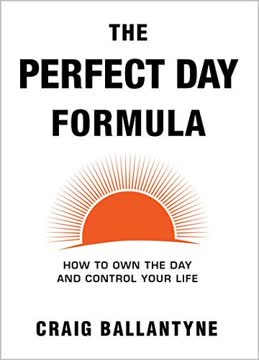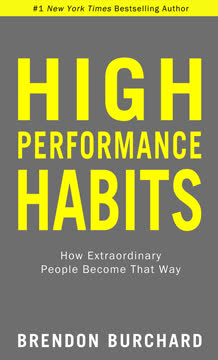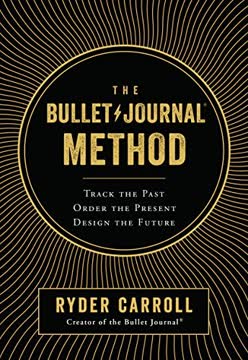Key Takeaways
1. Define Your Compelling Reasons
REASONS DRIVE ACTION.
Motivation is crucial. To successfully adopt the time chunking method as a habit, you need powerful, compelling reasons that will push you through obstacles and moments of laziness. Simply wanting to be "more productive" isn't enough; it's too vague and lacks the emotional weight needed for sustained effort. Your motivation must be deeply personal and significant.
Identify specific benefits. Drill down and ask yourself exactly how increased productivity will improve your life. The more specific and detailed your reasons, the more compelling they will be. Consider tangible improvements like reducing stress, sleeping better, earning more income, or freeing up time for loved ones or hobbies.
Make your reasons visible. Don't just think about your motivations; write them down. Create a physical list and keep it somewhere you'll see it regularly, like taped to your office wall. This constant visual reminder will prompt action and spur you to achieve your goals, especially when motivation wanes.
2. Master the Core Mechanics
The brain can only focus on a particular task for short periods of time.
Understand the basics. The traditional time chunking method involves scheduling your workday into 30-minute blocks: 25 minutes of focused work followed by a 5-minute break. After completing four such chunks, you take a longer 15-minute break. This structure aligns with the brain's natural ability to focus for limited periods.
Single tasks or batches. During the 25-minute work segments, concentrate on a single task to minimize distractions. For numerous small, related tasks (like paying bills or quick errands), use batch processing – group them together and complete as many as possible within one chunk. This reduces context switching and boosts efficiency.
Why it works. Time chunking is effective because it limits focus time, combats procrastination by making tasks seem less daunting (just 25 minutes!), reduces multitasking distractions, and encourages task completion by making you aware of the time spent. If you finish a task early, you can review or improve it, or simply end the chunk and take your break.
3. Customize the Method to Your Workflow
In order for any system to work in your life, it needs to complement your work process.
Personal suitability matters. No productivity system, including time chunking, is one-size-fits-all. For it to be truly effective and sustainable, you must adjust the basic mechanics to fit your unique lifestyle, work habits, and ability to focus. Trying to rigidly adhere to a system that doesn't suit you is a recipe for failure.
Experiment and adapt. Test different work segment and break durations to find what maximizes your productivity. If you find your groove after 25 minutes, try 40, 50, or even 90-minute work periods. Similarly, adjust break lengths to feel truly refreshed. Don't feel obligated to stop working if you're in flow when the timer goes off; keep going if it helps you finish the task.
Design your ideal schedule. Consider your daily energy fluctuations and personal commitments. If you're most focused in the morning, schedule longer work chunks then and shorter ones later. Modify the cycle length (e.g., 3 chunks instead of 4 before a long break). The goal is to create a flexible structure that supports your most efficient work, not someone else's.
4. Anticipate and Conquer Challenges
Every attempt to establish a new habit is beset by obstacles.
Obstacles are inevitable. Implementing time chunking will expose you to various challenges that can derail your efforts. Recognizing these hurdles in advance allows you to plan strategies to overcome them. These challenges come in many forms, both external and internal.
Common disruptions:
- Interruptions from colleagues, friends, or family who don't respect your work time.
- Lack of motivation, especially on days you feel tired or lazy.
- Distractions from technology (social media, news, email) and your environment.
- Erratic ideas or unrelated thoughts that pull you away from the task.
- Unanticipated emergencies that force you to abandon your schedule.
Develop coping strategies. Proactively address these issues. Turn off your phone and email notifications. Use browser extensions to block distracting websites. Train others to respect your work boundaries by setting expectations. When unrelated ideas strike, quickly write them down in a designated place and return to your task. For lack of motivation, revisit your compelling reasons.
5. Combine Time Chunking with Timeboxing
Why not use both techniques simultaneously to address both issues?
Different but complementary. Time chunking (short, focused work intervals with breaks) primarily addresses your ability to focus. Timeboxing (allocating a fixed, limited amount of time for a task or project) primarily addresses your ability to complete tasks and avoid perfectionism. Using both together creates a powerful synergy.
Timeboxing prevents scope creep. Parkinson's Law states that work expands to fill the time available. Timeboxing sets a deadline for a task, forcing you to work efficiently towards completion within that limit. This is particularly useful for projects where you might otherwise get bogged down in details or strive for unnecessary perfection.
Integrate the methods. Start by timeboxing a larger task or project, setting a realistic overall time limit (e.g., 2 hours for a blog post draft). Then, use the time chunking method to break that larger timebox into smaller, focused work segments (e.g., 25/5 or 50/10 chunks within the 2-hour limit). This ensures both focused effort and timely completion.
6. Optimize Your Foundation & Direction
Taking consistent and measured steps toward a clearly-defined goal ensures forward-moving progress and minimizes the likelihood of burnout.
Support your productivity. Your ability to work effectively within time chunks is heavily influenced by your physical and mental state. Prioritizing healthy lifestyle habits provides the necessary foundation for sustained focus and energy, directly impacting your productivity and resilience.
Key lifestyle factors:
- Sleep: Adequate rest (aim for 7+ hours) is crucial for focus, error reduction, and overall cognitive function. Naps can also help.
- Exercise: Regular physical activity boosts energy, reduces stress, improves mood, and enhances cognitive abilities like memory and focus.
- Diet: Eating nutritious foods provides stable glucose levels for brain energy, improving concentration and preventing crashes associated with junk food.
- Stress Management: Uncontrolled stress saps energy, reduces creativity, and impairs focus. Identify stressors and implement coping strategies like journaling, hobbies, or communication.
Prevent burnout. These healthy habits, combined with setting realistic work limits and taking real breaks (longer than 5-10 minutes), are essential preventative measures against burnout. Burnout leads to apathy, lethargy, and reduced output, making any productivity method ineffective.
7. Set Clear Goals and Track Progress
Without clearly-defined goals, it’s difficult to know whether the work you’re doing during your time chunks is moving you in the right direction.
Goals provide direction. Simply working in time chunks without clear objectives is like driving without a destination. Goals ensure that the focused effort you're putting in is contributing to meaningful outcomes in your life or work. Well-defined goals are essential for monitoring progress and maintaining motivation.
Traits of effective goals:
- Specific: Clearly state what you want to achieve (e.g., "write 2,000 words daily").
- Trackable: Include a way to measure your progress towards the goal.
- Complementary: Align with your desired lifestyle and long-term aspirations.
- Realistic: Be achievable given your current circumstances and constraints.
Monitor your performance. Tracking your progress against your goals allows you to evaluate your past performance and identify areas for improvement in your workflow. Simple tools like spreadsheets can help you log key metrics (e.g., daily word count, number of chunks completed) to stay on track and make informed adjustments.
8. Strategize Your Breaks Effectively
A 5-minute break is plenty of time to complete small tasks that are littering your to-do list.
Breaks are for recovery. The primary purpose of breaks between time chunks is to give your brain a rest and prevent mental fatigue. However, even short 5-minute breaks can be used constructively to tackle small, non-mentally taxing tasks that might otherwise accumulate and cause stress.
Productive break activities:
- Physical movement: Stretching, quick exercises (push-ups, squats), walking the dog, making your bed.
- Quick chores: Washing a few dishes, decluttering a small area (desk, car interior, drawer).
- Personal tasks: Paying a quick bill online, opening snail mail, making a reservation.
- Mental refreshers: Listening to one song, reading a comic strip or a few jokes, staring out a window.
- Planning/Review: Quickly reviewing your goals or tackling a few tiny items from your to-do list.
Avoid time sinks. Be mindful of activities that can easily extend beyond your allotted break time or re-engage your brain too intensely. Avoid checking email, social media, news sites, or getting into complex conversations or deep thinking tasks during short breaks. Plan your break activities ahead of time to maximize their effectiveness.
9. Leverage Tools Thoughtfully
Use the following list as a resource for generating ideas on how to get more out of the time chunking method.
Tools support the method. While the core of time chunking is discipline and habit, various tools and apps can assist you in implementing and optimizing the technique. The key is to choose tools that genuinely complement your workflow and help you achieve your goals, rather than becoming a distraction themselves.
Types of helpful tools:
- Timers: Simple countdown timers (like Google Timer or Marinara Timer) or dedicated time chunking apps (like Pomio, Promodoro, Focus Time, Pomodroido, PomodoroApp) to structure work and break intervals.
- Task Management: Apps like Remember The Milk or Toodledo to organize to-do lists, set deadlines, and track tasks, integrating with your time chunking sessions.
- Distraction Blockers: Browser extensions like Stayfocusd to limit access to time-wasting websites during work periods.
- Comprehensive Systems: More complex apps like IQTell or Omnifocus (Mac only) that integrate email, calendars, and task management for GTD-style organization.
Focus on function. Don't get caught up in having the latest or most feature-rich app. Identify the specific function you need help with (timing, task lists, blocking distractions) and find a simple, reliable tool that serves that purpose. The tool should facilitate your time chunking, not complicate it.
10. Stop Planning, Start Doing
Stop Reading And Start Taking Control Of Your Time!
Application is key. You can read all the books and guides on productivity in the world, but none of the information will benefit you unless you put it into practice. True learning and improvement come through application and consistent action. The time chunking method, like any habit, requires diligent implementation.
Embrace imperfection. Don't wait for the perfect moment or the perfect system to start. You will experience false starts, distractions, and days when you fall off track. Failure is a natural part of the habit-building process. Learn from these setbacks, identify what went wrong, and adjust your approach.
Take control now. The most important step is the first one: start using the time chunking method today. Choose a task, set your timer for your chosen work interval, and begin. By taking immediate action, you begin the process of building a powerful habit that can significantly increase your productivity and give you more control over your time.
Last updated:
Review Summary
The Time Chunking Method receives mostly positive reviews, with readers praising its practical approach to productivity. Many find the book concise, easy to read, and helpful for implementing time management strategies. Readers appreciate the flexibility of the method and its adaptability to different work styles. Some criticize the book for being too basic or similar to existing techniques like the Pomodoro method. Overall, reviewers find the book valuable for improving focus, completing tasks, and managing time more effectively in both personal and professional settings.
Similar Books










Download PDF
Download EPUB
.epub digital book format is ideal for reading ebooks on phones, tablets, and e-readers.













